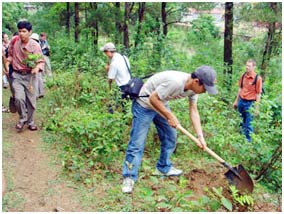Every year, tens of thousands of animal and plant species are extinct
Each year, there are 18,000 - 55,000 more extinct animal and plant species. The cause is due to human activities. Alarm from the Secretariat of the Convention on Biological Diversity.
The extinction rate is multiplying by 1,000 times the base extinction rate: 3 species disappear every hour; every day 150 species are lost; every year 18,000 - 55,000 species of animals and plants are extinct. The above are data provided by Mr. Ahmed Djoghlaf, Executive Secretary of the Secretariat of the Convention on Biodiversity, on the occasion of International Day of Biodiversity (May 22).
The theme of the Biodiversity Day (2007) is "Climate change and biodiversity".

Planting trees - contributing to biodiversity conservation (Photo: Diem Ha)
According to Ahmed Djoghlaf, recently, in the report of the Intergovernmental Panel on Climate Change, 2,500 experts from 130 countries have pointed out that the accumulation of carbon dioxide (CO 2 ) in the atmosphere is at an unprecedented level. now has been in the past 650,000 years.
The cause is due to human activities.
Ahmed Djoghlaf also said that 1,395 scientists from 95 countries have also demonstrated negative impacts caused by human activities on nature. Accordingly, humans are witnessing the biggest wave of extinction since the dinosaurs disappeared on Earth.
The Secretariat of the Convention on Bio-diversity also warned that by the end of the century, many species and ecosystems will be struggling to adapt to changes in temperature, rainfall and extinction rates. . It is evident that polar bear disappearance disappears due to reduced ice; or climate change that reduces the lake water level in Africa by about 30%, resulting in about 25-40 numbers of African endemic species that may disappear in 2085.
This suggests that climate change is an important cause of biodiversity degradation. At the same time, biodiversity degradation and degradation of natural habitats also contribute to climate change.
Mr. Ahmed Djoghlaf said that when policy makers around the world today pay special attention to the role of biodiversity - a factor often overlooked in climate change coping strategies. From there, it can help the poorest people adapt to the changing weather to improve their quality of life.
Accordingly, if jointly addressing the threats that lead to the weakening of biodiversity and addressing climate change issues, people are likely to increase their adaptability to new challenges in the next decade. . At the same time, ensure life for the poorest of the poor.
Kieu Minh
- Nearly 21,000 species of plants and animals are about to become extinct
- More than 860 wildlife species have become extinct
- Con Dao: Tens of thousands of hatched baby turtles each year
- 10 endangered animals
- Regenerating extinct animals
- More than 500 species of birds in the world are extinct
- Discover dozens of new animal and plant species in Indonesia
- Why are tens of thousands of walruses stuck on Alaska beaches every year?
- The evolution of animals does not keep pace with extinction
- In most species, fidelity is just a fantasy
- Thousands of animal and plant species are threatened in Mexico
- Tens of thousands of species may disappear
 Why do potatoes have eyes?
Why do potatoes have eyes? 'Tragedy' the world's largest carnivorous life: Death becomes ... public toilet
'Tragedy' the world's largest carnivorous life: Death becomes ... public toilet Tomatoes were once considered 'poisonous' for 200 years
Tomatoes were once considered 'poisonous' for 200 years Detecting microscopic parasites on human face
Detecting microscopic parasites on human face The temperature of the Earth increases, making the marine ecosystem strong
The temperature of the Earth increases, making the marine ecosystem strong  There is a world of creatures living under our feet
There is a world of creatures living under our feet  Vietnam is losing its biodiversity
Vietnam is losing its biodiversity  Biodiversity: A balance between conservation and exploitation is needed
Biodiversity: A balance between conservation and exploitation is needed  Humans are at risk because the animals decline too limited
Humans are at risk because the animals decline too limited  More than 152 rare and precious animal and plant species are in danger of extinction
More than 152 rare and precious animal and plant species are in danger of extinction 